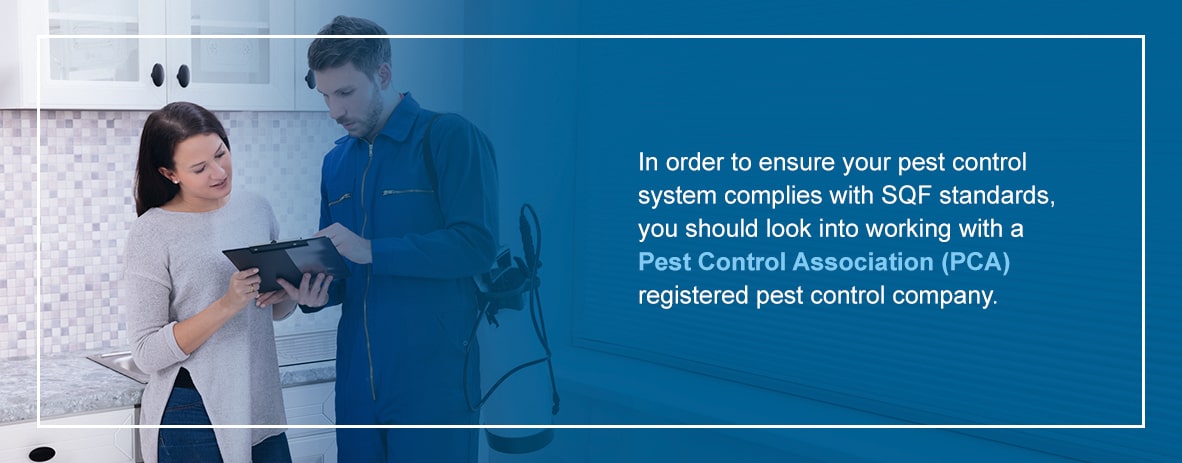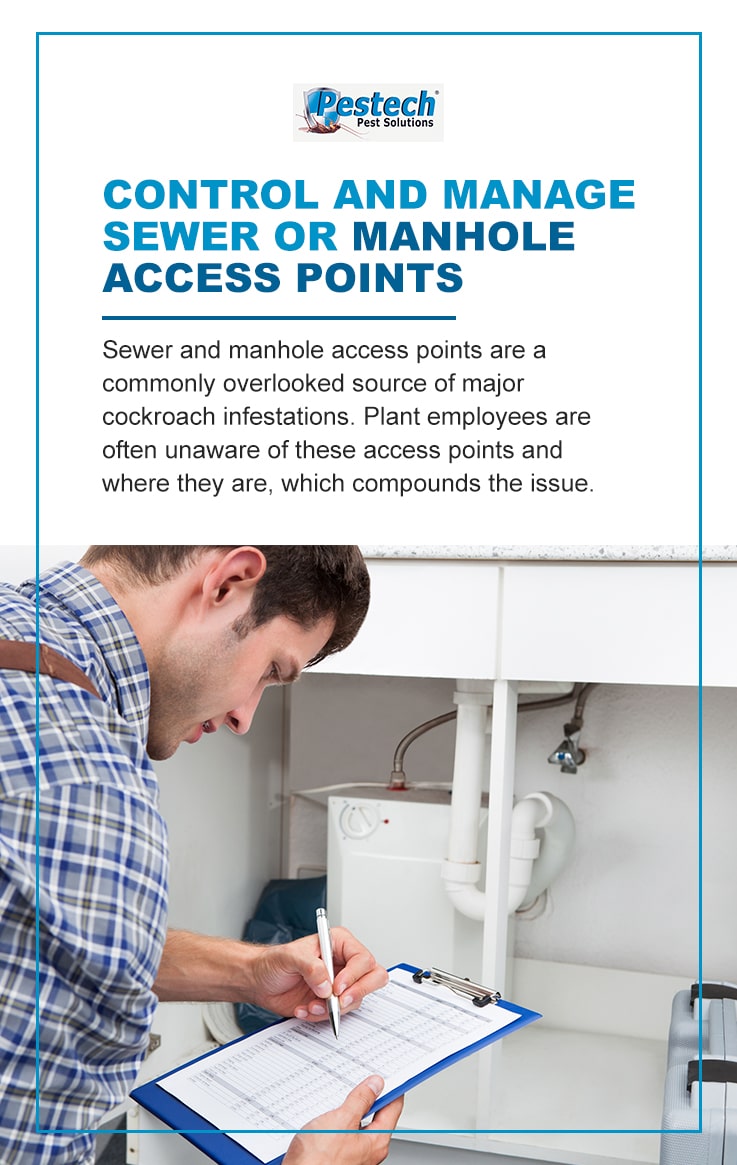How Pest Control Can Help You Prepare for an SQF Audit

A Safe Quality Food (SQF) audit is required by the Global Food Safety Initiative (GFSI) to ensure your business is worthy of receiving an NSF Food Safety Certification. You are graded based on the number of Hazard Analysis Critical Control Points (HACCP) you earn throughout the audit. A large part of the audit consists of pest management solutions and the precautions taken to prevent pest-related issues.
Pest management is an important part of the audit, and passing it means meeting a lot of different standards. This guide will help you avoid common pest management mistakes made during SQF audits so you can pass with flying colors. Find out everything about what an SQF audit is, the standards involved and what the audit prioritizes during pest-related inspections.

Pest Control and SQF Audits
All businesses and establishments that work or specialize in making and handling food need a proactive system for dealing with pests. These systems are implemented to help you prevent the contamination of any products, packing or raw materials. Your system must support efforts to minimize pest activity and ensure you can properly respond to the first signs of an infestation.
In order to ensure your pest control system complies with SQF standards, you should look into working with a Pest Control Association (PCA) registered pest control company. Together, you and the company must be able to create an effective way of monitoring pest activity, responding to it and dealing with it properly while adhering to health codes and the GFSI’s standards.
In some cases, third-party pest control operators (PCOs) may need more experience with SQF requirements. For this reason, you must ensure the PCO you hire works with your SQF consultant to comply with the necessary standards. Confirming compliance is a vital part of preparing for an SQF audit.
Once the PCO and your company understand what needs to be done to meet the passing standards of your SQF audit, you can start working on a pest control system. SQF auditors spend significant time reviewing pest control systems, as they play a critical role in whether a business can earn a Food Safety Certification.
For further information, it is recommended that you familiarize yourself with Edition 9 of the Food Safety Codes, which is the most updated edition and has been in effect since May 24, 2021.
The following is a breakdown of what a typical pest management contract agreement defines:
- Key contact personnel: Company and contractor personnel to be contacted, as well as emergency call-out procedures.
- Description of services: A detailed description of the services provided by the PCO laying out how they will be completed. The terms of the contract must also be clearly defined.
- Equipment: Equipment and material storage specifications and a comprehensive inventory of pesticides, which must be approved by the regulatory authority and declared safe to use in a food-handling facility. The safe use and application of baits, traps, sprays and fumigants must also be covered.
- Records: Records to be maintained and the requirement to notify the facility of any and all changes in the services or materials used.
- Service personnel: A list of service personnel involved as well as evidence of competency through the completion of an exam from a recognized organization.
The following is what a pest management service should provide to your company:
- Visits and inspections: Regular site inspections and visits are standard fare, and should include the periphery, exterior and interior of your buildings. A documented risk assessment determines these visits and their frequency. This assessment contains service records, describes the current levels of pest activity and provides recommendations on corrective actions to take.
- Detailed outlines: A diagram of your sites detailing the location of all pest control prevention and monitoring systems.
- Quarterly inspections: Every quarter, a biologist must visit sites and provide trend reports and recommendations.
- Presentation of documentation: A copy of the PCO’s most recent certificate of insurance is to be provided to specify liability coverage.
- Spill control: Procedures and materials to prevent and rectify any spills.
- Safety data: A data sheet with information on the safety of materials used to ensure proper application of chemicals.
Successfully passing an SQF audit involves numerous steps. The following pest control measures will prepare your facility for inspection.
Address Evidence of Activity
You need to address evidence of pest activity to earn points and perform well during an inspection. The presence of rodent droppings anywhere in warehousing areas, signs of chewed food and packaging material, deceased pests in traps and ongoing infestations will significantly impact your score. These unaddressed signs of activity can lead your SQF auditor to deem your site unsuitable for the manufacturing and storage of food, which is why it’s so vital that these issues are properly addressed.
SQF practitioners prioritize a few specific locations and areas in their inspections. Perimeter doors, bulk food upload stations, loading bays, pallets, high beams, silo bases, suspended ceilings, piping, conduits and elevated areas are important parts of an auditor’s Good Manufacturing Practices (GMP) inspection checklist.
Act on Pest Control Recommendations to Reduce Risk
Acting on the guidance given to you by pest control experts is a reliable way of improving the number of HACCP you earn during your audit. Trust the recommendations given to you by experts and enact them as soon as you possibly can — they are guaranteed ways of reducing the risk of pest activity in your facilities. Recommendations can range from simple to elaborate, from adding a door sweep to block a door gap to a detailed response plan.
Recommendations that are ignored, especially if they are repeatedly ignored, will definitely catch an auditor’s eye and cost you precious points. To avoid this, regularly review proof of service reports from your PCO after each service and implement all recommendations given to optimize your pest control measures.

Ensure Pest Control Devices Are Working Correctly
Food processing facilities see constant activity. It’s possible for a pest monitoring or baiting station to be disturbed by heavy machinery or knocked out of place by mistake by a floor worker. Humidity and moisture can cause traps to rust, or a malfunctioning component of a trap may be overlooked. That being said, these issues are not taken lightly during audits. Your score can be greatly affected by malfunctioning or poorly maintained traps and control measures.
These deductions are avoidable. Make sure your pest control provider is actively and regularly checking the integrity and condition of all devices, bait stations and traps. You must also report any malfunctioning equipment and devices. The people who check pest control devices lower the chance of anything breaking or failing to meet standards during an inspection.
If an issue is noticed between visits and inspections, it must be reported to your provider immediately. This way, they can prepare new equipment or schedule necessary repairs. Scheduling a pre-audit inspection with your pest control providers to make sure everything is functioning and in good condition will likely have a significant impact on your SQF audit score.
Be Mindful of Fence Line Issues
Fence line issues are often dismissed because they are outside your premises’ boundaries or because they’re out of sight and out of mind. However, fence line issues should be a part of your pest control plan. Conditions that attract pests may be outside your property but can still become your problem if left unattended. Addressing these sooner rather than later will definitely help you score more positive points on your audit.
Food processing plants are commonly located near farms and fields, which are home to many different pests that can easily migrate into your plant. Understanding the risks posed by your neighboring properties is an essential part of effective fence line planning. Developing a strategy for dealing with potential and existing fence line issues is a valuable measure that can help you pass your SQF audits with flying colors.
Adjust Outdoor Lighting to Prevent Insect Issues
Your exterior lighting can attract flying pests such as moths and other insects that are drawn to light. Bright lights angled at doors and other plant entry points can attract these winged invaders into your facility, where they can cause concerns as they lay eggs and cause other violations which will affect your SQF audit.
Consult your PCO about the best types of lighting to use, especially near entrances, to avoid attracting flying insects into your plant. They will be able to recommend the right bulb or light source to mitigate this risk.
Clean up Accumulated Debris
Food and beverage production plants have a great deal of ingredients and products moving through their various zones. During production, the equipment involved can generate moisture buildup and food particulates. This type of debris can settle anywhere in your plant, where it builds up quickly and attracts pests if left unattended.
The accumulation of debris is noticed during SQF audits because of its potential sanitation violations and ability to attract pests.

Control and Manage Sewer or Manhole Access Points
Sewer and manhole access points are a commonly overlooked source of major cockroach infestations. Plant employees are often unaware of these access points and where they are, which compounds the issue. It is important that everyone working at your facility is aware of these locations and understands their potential for attracting problematic pests.
Consult with your pest management providers about finding ways to monitor these areas so you can minimize the risk of an infestation and the problems it might cause. Your plan needs to include preventive measures for infestations arising from these access points before they can develop and become significant issues.
Develop a Comprehensive HACCP Plan
Follow these steps to design a comprehensive plan to ace your inspections and earn more HACCP during your SQF audits.
- Assemble an HACCP team: This multidisciplinary team uses its expertise and knowledge of the product and process to keep it up to SQF standards every step of the way. This team should include people from engineering, sanitation, quality assurance, research and production.
- Define the product: Your team needs a general description of the ingredients used, the food made and the processing methods involved to develop a thorough understanding of it. Be sure to include Information about storage, temperature conditions, distribution and other important aspects.
- Identify product intended use and consumers: Define how the food is intended to be used and who the main audience is.
- Create diagrams: Creating a flow diagram to lay out information in an easy-to-understand format is always beneficial. It helps team members understand the entire process and where they fit in. It also identifies points of the process that are more vulnerable to pest problems and what to do in specific situations. Be sure to get on-site confirmation of this flow diagram and make any modifications that might be necessary.
- Conduct a pest analysis: There are two parts to this process. Pest problem identification and pest problem evaluation.
- Determine the critical control points: Critical control points are stages where control can be applied to prevent or eliminate a food safety hazard or pest control issue. Identify which dangers and pest problems might arise at each critical control point and determine a plan of action for each of them. Examples of critical control points include processing, packing and docking areas.
- Establish effective monitoring systems for each control point: Your monitoring system should help everyone understand how to monitor their situations, what to look out for and how to respond to specific circumstances.
- Establish corrective action plans: Make sure everyone involved knows what needs to be done and how to implement, record or request corrective actions.
- Establish verification procedures: It is vital that all parties understand what processes to undergo for actions to be ordered, who to go through and how they are sorted out.
- Determine record-keeping and documentation processes: For an effective HACCP system to run smoothly, everyone involved needs to know where to find all the relevant documentation. The documentation process, what records need keeping and how to use this information to help your system are the keys to finishing off your plan properly.
Prepare Your Restaurant, Plant, Hotel or Business to Pass an SQF Audit
Passing SQF audits and receiving your Food Safety Certification are critical for any business working with food. Pestech Pest Solutions can help you create the perfect plan to manage your pest management, monitoring and handling issues. We are professionals with years of experience and top-notch training who will get the job done safely and thoroughly.
We are the largest family-owned pest management center in Pennsylvania, and we take the work we do very seriously. With our advice, thoroughness and extensive range of services, you’ll know your business complies with SQF standards at all times, allowing you to rest assured that your operation will pass any audit.
To find out more about the industry services and solutions we offer, and to learn more about what we can do for you specifically, contact us at any time and we’ll make a plan to help you keep your business safe.

